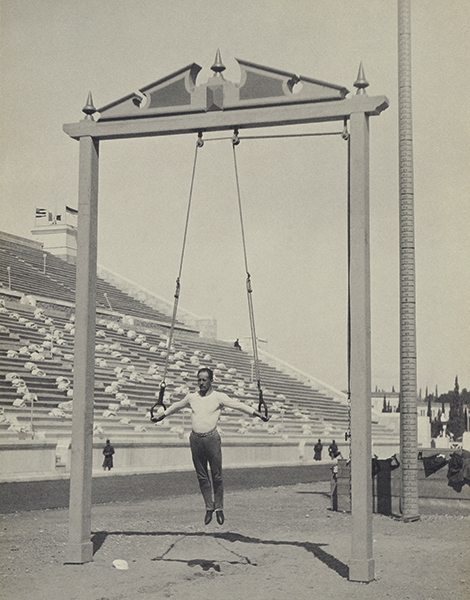Capturing Greece: Wolfgang Bernauer’s Photographic Journey
Discover how Swiss photographer Wolfgang Bernauer...

Greek gymnastics teams practicing
© Albert Meyer
On April 6, 1896, the 27-year-old American James Brendan Connolly became the first modern Olympic champion. He dominated the triple jump with a leap of 13,71 meters and took second and third place in the high jump and long jump respectively. He was immortalized holding the American flag by Albert Meyer, the official photographer of the German Olympic Team. Any reference now to the American athlete on the internet is always accompanied by the German photographer’s famous image.
Albert Meyer was born in 1857 in Klotzsche and studied in Dresden and the US. In 1895, he became a member of the German Olympic Committee for the Athens Games. An athlete himself -a cyclist and excellent marksman – he wanted to witness the huge sporting event from up close. The following March he headed with his wife from Berlin to Brindisi and, from there, reached Corfu on a small ship.
His arrival in Athens took on an official character and was triumphantly announced by the local press. Clippings of the time suggest that his ultimate aim was not simply to capture the Games in images on behalf of the German Komitat but to make a photo album which would be offered to Committee members and official guests as a souvenir gift.

Panayiotis Paraskevopoulos takes up his position for the discus throw
© Albert Meyer

Hermann Weingärtner, who placed third on the rings
© Albert Meyer
Although he was an acclaimed professional before he left for Athens, Meyer gained moral and material benefits from the creation of the album, while his name became inextricably linked with the revival of the Modern Olympic Games. Upon returning to Germany, he was appointed as the “Court Photographer” of the the Duke of Saxe-Altenburg and received 200 francs. The next year, in 1897, King George 1 of Greece awarded him for his service with the badge of the Knights’ Cross of the Order of the Redeemer.
The photographs that have survived reveal an artist with a pioneering eye, a very good sense of light and exceptional capabilities of composition. However, what made him unique was the way he perceived and captured the Games.
His shots were not limited to competitive action but covered every aspect of this important athletic event – from the entry of the brass bands on to the field, to the runners on the starting line, the award ceremony, the handshakes between athletes before the start of their event, the relaxed commemorative poses of the national delegations and members of the Organizing Committee, the ladies dragging their hems as they enter the stadium and the official guests standing in their top hats anxiously watching events.
His poignant photos capture the climate of an entire era and the atmosphere surrounding the revival of a great idea.
Every Greek and foreign publication about the history of the Olympic Games is based on his photos while, in his book Sportphotographie 1860-1960, the author Jean Lattes refers to him as the first Olympic Games photo-journalist.
His archive was destroyed the bombing of Berlin at the end of World War II making the album – a copy of which is kept in the Historical Archive of the Benaki Museum – a rare and valuable testimony of a bygone era.
Visual artist Eva Nathena and her associates, video artist Angelos Papadopoulos and musician Giorgos Poulios, take an original video-art approach to transport us back in time, to Athens in 1896 and the modern revival of the most important games of antiquity.
The exhibition “Olympic Games 1896: The historic photographs of Albert Meyer from the Benaki Museum collections through the eyes of Eva Nathena” is the fruit of cooperation between the Benaki Museum, Costa Navarino and Athens International Airport and showcases the photo album of Albert Meyer, the official photographer of the German Olympic team, bringing his shots to life with sound and motion and elevating the unique photographic experience he has given us. Athens International Airport “Eleftherios Venizelos”: to 16/09; Costa Navarino: to 30/11.
Discover how Swiss photographer Wolfgang Bernauer...
The Olympic elite, Hollywood’s finest, the...